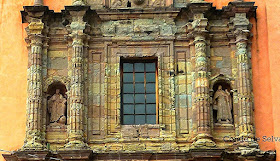Here are some recently published books on various aspects of the arts and culture of Mexico that may be of interest to our readers:
University of New Mexico Press October 2017
Over the years, Beverley Spears, an architect and connoisseur of architecture, has devoted much time and effort to visiting and photographing most of these historic mission buildings across Mexico and documenting the regional nuances of style. In this new book, with her architect’s eye, she makes a valuable contribution to this effort, bringing their richness and variety to a larger public.
Wisely she has chosen black and white photography to document the conventos, with a special focus on their distinctive physical environments. As she notes in her Introduction, this approach “removes the distraction of color and helps convey architectural form, space and light and gives a timeless quality to the photographs which is appropriate for these monuments nearly half a millennium in age.”
from the Foreword
"The commissioning and censorship of [Diego] Rivera by the Rockefellers in the 1930s is a well-known episode in American art history, and much has been written about it. And yet, the story has become somewhat simplistic. Paquette’s book enriches the story and reveals that, in order to understand this episode in American art history, we need to consider more than simplistic or Manichean conceptions of good socialist art versus bad capitalist patron.
No one else has gone into such rich depth in their analysis of either the mural or the relevant contexts in which its meaning was debated, shaped, and determined. I believe this book will have a wide readership within and beyond academic audiences.”
Mary K. Coffey, Dartmouth College
First published in 1960 in the series Jalisco en el Arte by the eminent architect and historian Sergio Zaldívar, this was the first publication to document and identify the unique architectural and sculptural style of the rural Jaliscan baroque, with full commentary on the most important buildings.
This recent second edition (2015) contains all the original text and illustrative material in a large format. Although the photographic quality is uneven, the text and graphics remain of great value and interest to students of Mexican colonial architecture and its associated arts.
 University of Oklahoma Press (October 2017)
University of Oklahoma Press (October 2017)
This beautifully illustrated new book is the culmination and integration of the author's various studies of the religious, cultural and artistic traditions of Yanhuitlan and its historic Dominican priory in the Mixtec region of Oaxaca.
Frassani relates the history of Yanhuitlan by examining the rich store of art and architecture in the town’s church and convent, bolstering her account with more than 100 color and black-and-white illustrations. She presents the first two centuries of the church complex’s construction works, maintenance, and decorations as the product of cultural, political, and economic negotiation between Mixtec caciques, Spanish encomenderos, and Dominican friars. The author then ties the village’s present-day religious celebrations to the colonial past, and traces the cult of specific images through these celebrations’ history. Cultural artifacts, Frassani demonstrates, do not need pre-Hispanic origins to be considered genuinely Mesoamerican—the processes attached to their appropriation are more meaningful than their having any pre-Hispanic past.
Based on original and unpublished documents and punctuated with stunning photography, Building Yanhuitlan combines archival and ethnographic work with visual analysis to make an innovative statement regarding artistic forms and to tell the story of a remarkable community.

- Cambridge Latin American Studies (Book 103) Cambridge University Press (October 3, 2016)

"The distillation of a lifetime of study, Theater of a Thousand Wonders tells a story of affection, veneration, petition and grace across the Mexican landscape in the colonial period. Careful, attentive, and reflective, William B. Taylor examines how shrines were founded, what made them succeed or fail, how they changed over time, and the material aspects of their miracle-workings images. His wise work finds universal patterns in the local and recalls the marvelous side of long-forgotten lives."
William A. Christian Jr., author of Local Religion in Sixteenth-Century Spain
''Theater of a Thousand Wonders is a remarkable work of scholarship. Bringing together decades of research on the saints, shrines, images and miracles of colonial New Spain, William Taylor not only offers a beautifully written panorama of the country's religious geography, but also a thoughtful examination of the meanings of such places and events for the colony's everyday Catholics. Embracing meditations on race, material culture, art, and the history of emotions, it is one of the great contemporary works of religious history..."
Benjamin Smith, The University of Warwick



























